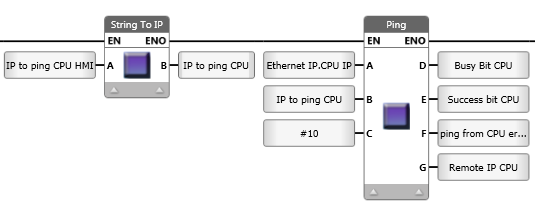
Use the Ping function to ping a remote device.

|
Parameter Name |
Purpose |
A |
Sender IP: CPU or Panel |
This is the IP which sends the Ping |
B |
Destination: IP to Ping |
Enter
the IP of the remote device to Ping. |
C |
TimeOut: milliSec |
Determines how long the controller will wait for a response from the remote device. |
D |
Ping in Progress |
Turns
OFF when the first of these events occurs: |
E |
Success Bit |
Turns
ON when the remote device answers. |
F |
Error code |
Ping supports the standard ICMPv4 Destination Unreachable Message Subtypes listed in the following table. |
G |
Remote IP |
The IP of the device that answered the Ping. |
Error Codes (ICMPv4) |
Purpose |
-2 |
Timeout exceeded– no reply at all |
-1 |
No error |
0 |
Network Unreachable The datagram could not be delivered to the network specified in the network ID portion of the IP address. Usually means a problem with routing but could also be caused by a bad address. |
1 |
Host Unreachable The datagram was delivered to the network specified in the network ID portion of the IP address but could not be sent to the specific host indicated in the address. Again, this usually implies a routing issue. |
2 |
Protocol Unreachable The protocol specified in the Protocol field was invalid for the host to which the datagram was delivered. |
3 |
Port Unreachable The destination port specified in the UDP or TCP header was invalid. |
4 |
Fragmentation Needed and DF Set Normally, an IPv4 router will automatically fragment a datagram that it receives if it is too large for the maximum transmission unit (MTU) of the next physical network link the datagram needs to traverse. However, if the DF (Don't Fragment) flag is set in the IP header, this means the sender of the datagram does not want the datagram ever to be fragmented. This puts the router between the proverbial rock and hard place, and it will be forced to drop the datagram and send an error message with this code. This message type is most often used in a “clever” way, by intentionally sending messages of increasing size to discover the maximum transmission size that a link can handle. This process is called MTU path discovery. |
5 |
Source Route Failed Generated if a source route was specified for the datagram in an option but a router could not forward the datagram to the next step in the route. |
6 |
Destination Network Unknown Not used; Code 0 is used instead. |
7 |
Destination Host Unknown The host specified is not known. This is usually generated by a router local to the destination host and usually means a bad address. |
8 |
Source Host Isolated Obsolete, no longer used. |
9 |
Communication with Destination Network is Administratively Prohibited The source device is not allowed to send to the network where the destination device is located. |
10 |
Communication with Destination Host is Administratively Prohibited The source device is allowed to send to the network where the destination device is located, but not that particular device. |
11 |
Destination Network Unreachable for Type of Service The network specified in the IP address cannot be reached due to inability to provide service specified in the Type Of Service field of the datagram header. |
12 |
Destination Host Unreachable for Type of Service The destination host specified in the IP address cannot be reached due to inability to provide service specified in the datagram's Type Of Service field. |
13 |
Communication Administratively Prohibited The datagram could not be forwarded due to filtering that blocks the message based on its contents. |
14 |
Host Precedence Violation Sent by a first-hop router (the first router to handle a sent datagram) when the Precedence value in the Type Of Service field is not permitted. |
15 |
Precedence Cutoff In Effect Sent by a router when receiving a datagram whose Precedence value (priority) is lower than the minimum allowed for the network at that time. |
 |
The combined maximum number of active requests for DNS Resolver and PIN is 16. |